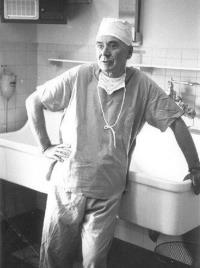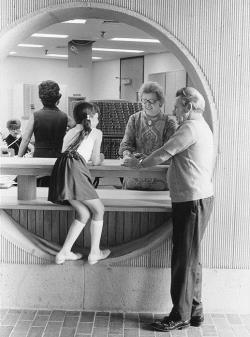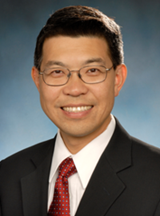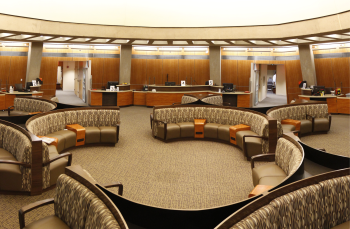The Hospital of the University of Pennsylvania opened in 1874. That same year, Dr. William F. Norris was appointed the first Professor of Ophthalmology at the University of Pennsylvania.
Early Leaders in Ophthalmology
On February 3, 1874, Dr. William Fisher Norris became the first Professor of Diseases of the Eye at the University of Pennsylvania (Penn), the fourth such appointment made in the United States. Dr. Norris was committed to teaching and research, and was instrumental in the founding of the Hospital of the University of Pennsylvania (HUP), one of the first University-owned hospitals dedicated to medical student education. HUP began admitting patients in June 1874. The facility included an eye clinic in the basement, the original location of Penn's Department of Ophthalmology.
Following Dr. Norris’s unexpected death in 1901, the University of Pennsylvania Trustees elected Dr. George E. de Schweinitz the second Chairman of Ophthalmology. Under Dr. de Schweinitz’s leadership, the eye dispensary and ophthalmic pathology laboratory were renovated and enlarged, and an operating room for eye surgery was created. Dr. de Schweinitz sought to establish standards for ophthalmic care nationally, helping to found the American Board of Ophthalmic Examination (renamed the American Board of Ophthalmology), the nation's first certifying board. He was also the first and only ophthalmologist to be President of the American Medical Association. Dr. de Schweinitz maintained a large practice, counting President Woodrow Wilson among his prominent patients.
In 1924, Dr. Thomas B. Holloway succeeded Dr. de Schweinitz as Chairman. Dr. Holloway was deeply invested in teaching, having previously led development of an ophthalmology training program in the newly established Graduate School of Medicine in 1916. Dr. Holloway introduced a number of clinical upgrades to the department, such as a slit lamp microscope in the eye dispensary and a laboratory of perimetry for visual field testing.
Establishing the Residency Program
When Dr. Francis Heed Adler became the Chairman of Ophthalmology in 1936, ophthalmology residencies were emerging across the United States. Ophthalmologists were beginning to train domestically rather than traveling to European institutions. Dr. Adler recognized the importance of promoting innovative clinical research and growing the next generation of medical leaders at Penn. He advocated for an expanded ophthalmology clinic that would provide the necessary facilities for resident training. In 1937, the Ophthalmology Department introduced the first residency program at Penn, welcoming Drs. Jerry Smith and Harold G. Scheie as the first residents.
Dr. Scheie and a New Eye Institute
 Dr. Harold G. Scheie succeeded Dr. Adler as Chairman in 1960. Clinical research and the residency program flourished under Dr. Scheie, who created an elective five-year training program that provided residents two years of research and advanced study in related basic sciences. In the 1960's, members of the Department contributed to the ophthalmic literature on topics including cataracts, glaucoma surgery, treatment of hyphema, and the description of Hurler's disease, and Dr. Scheie pioneered glaucoma research and treatment methods.
Dr. Harold G. Scheie succeeded Dr. Adler as Chairman in 1960. Clinical research and the residency program flourished under Dr. Scheie, who created an elective five-year training program that provided residents two years of research and advanced study in related basic sciences. In the 1960's, members of the Department contributed to the ophthalmic literature on topics including cataracts, glaucoma surgery, treatment of hyphema, and the description of Hurler's disease, and Dr. Scheie pioneered glaucoma research and treatment methods.
By the late 1960's, the Department of Ophthalmology had outgrown its clinical and laboratory facilities. The development and expansion of ophthalmic subspecialties required more equipment and space. Dr. Scheie led fundraising efforts for a new eye hospital and opened the Scheie Eye Institute in 1972.
Expanding Services and Centers
 Within the round walls of the Scheie Eye Institute, the next leader of the Department, Dr. Myron Yanoff, fostered the growth of subspecialties. During his chairmanship (1978-1986), he established retina, cornea, glaucoma, and oculoplastic surgery services, all of which were designed to offer cutting-edge patient care and to train the country's finest ophthalmologists.
Within the round walls of the Scheie Eye Institute, the next leader of the Department, Dr. Myron Yanoff, fostered the growth of subspecialties. During his chairmanship (1978-1986), he established retina, cornea, glaucoma, and oculoplastic surgery services, all of which were designed to offer cutting-edge patient care and to train the country's finest ophthalmologists.
In 1991, Dr. Stuart L. Fine came from Johns Hopkins University’s Wilmer Eye Institute to become the seventh chair of Penn's Department of Ophthalmology. He brought with him a keen interest in public health and epidemiology, resulting in the creation of the Center for Preventive Ophthalmology, Biostatistics and Epidemiology in 1994, and the appointment of a full-time director, Maureen Maguire, PhD. This center has orchestrated a community outreach program to bring eye care to medically under-served individuals, as well as research programs with mentoring for students and faculty.
In the 1990s, the Department's research programs began to increase focus on molecular medicine (genetics). The establishment of the F. M. Kirby Center for Molecular Ophthalmology has made it possible for molecular geneticists to investigate the genetic causes of eye conditions including cataracts, myopia, macular degeneration, and other retinal degenerations. Over the next few decades, researchers continued this work, leading to the first gene therapy for a hereditary eye condition to be developed and approved by the Federal Drug Administration in December 2017.
Current Leadership
 We are pleased to announce the appointment of Bennie H. Jeng, MD, as Chair of the Department of Ophthalmology and director of the Scheie Eye Institute at Penn Medicine. A nationally recognized clinician-scientist specializing in cornea and external eye diseases, Dr. Jeng is currently Professor and Chair of the Department of Ophthalmology and Visual Sciences at the University of Maryland School of Medicine (UMSOM). His appointment at Penn Medicine takes effect July 1.
We are pleased to announce the appointment of Bennie H. Jeng, MD, as Chair of the Department of Ophthalmology and director of the Scheie Eye Institute at Penn Medicine. A nationally recognized clinician-scientist specializing in cornea and external eye diseases, Dr. Jeng is currently Professor and Chair of the Department of Ophthalmology and Visual Sciences at the University of Maryland School of Medicine (UMSOM). His appointment at Penn Medicine takes effect July 1.
Dr. Jeng began his distinguished academic career at the Cleveland Clinic in 2003, where he established himself as an NIH funded clinician-scientist. In 2008, he transitioned to the University of California San Francisco (UCSF), where he rose through the academic ranks, serving as co-director of the UCSF cornea service, director of the Proctor/UCSF Cornea Fellowship program, and as Chief of Ophthalmology at the San Francisco General Hospital. Dr. Jeng was recruited to the University of Maryland in 2013, where under his transformative leadership, the Department of Ophthalmology expanded its clinical service from 3 to 12 sites, grew its research faculty, increased the number of endowments, and recreated its residency program.
Dr. Jeng has had a broad institutional as well as global impact. At UMSOM, he served as founding Medical Director of the Multispecialty Ambulatory Surgical Center and as co-chair of the UMSOM Promotions Reform Committee and was actively involved in medical education, serving as one of the inaugural leaders of the house system for UMSOM medical students. Dr. Jeng is also a regular surgical instructor overseas, having taught corneal transplantation in numerous countries, including India, China, and Kuwait. During the COVID-19 pandemic, he has been providing international surgical instruction virtually.
Dr. Jeng earned his bachelor’s degree from Washington University and his MD from the Perelman School of School of Medicine in 1998. He completed his ophthalmology residency at the Cole Eye Institute of the Cleveland Clinic, followed by a fellowship at UCSF. He also holds a Master’s degree in Clinical Investigation.
At the national level, Dr. Jeng has been actively involved in the leadership of many ophthalmologic societies, including serving as President of the Cornea Society, President of the Eye and Contact Lens Association (formerly CLAO), and on the Board of Directors of the American Board of Ophthalmology. He also serves in leadership positions on several committees of the American Academy of Ophthalmology, and he has served recently on the Board of Directors of the Eye Bank Association of America. He was a past editorial board member for JAMA Ophthalmology, and he currently serves as Associate Editor for Ophthalmology (official journal of the AAO), as a Senior Editor for Cornea, and as Editor-in-Chief for Eye and Contact Lens.
In keeping with his impact, Dr. Jeng has received numerous awards, including the Senior Achievement Award and the Secretariat Award from the American Academy of Ophthalmology, as well as resident teaching awards from the Cleveland Clinic and at UCSF.
Dr. Jeng’s appointment follows a national search led by Frances Jensen, MD, FACP, Arthur Knight Asbury MD Professor and Chair of the Department of Neurology. We are grateful to Dr. Jensen and the Search Committee for their thorough work to bring Dr. Jeng to Penn Medicine. Dr. Jeng’s appointment as Chair of the Department of Ophthalmology begins the next phase of leadership of the Scheie Eye Institute and this outstanding department which, under the longtime leadership of Joan O’Brien, MD, has established itself as among the very best in the country.
Please join us in congratulating Dr. Jeng on his appointment and welcoming him back home to Penn
Scheie Eye Institute Recent Renovations
 In 2014, extensive renovations and modernization of the Scheie Eye Institute were completed, including state-of-the-art exam and procedure rooms; corridor access to the rest of Penn Presbyterian Medical Center; and a new lobby equipped with an automated check-in system, comfortable seating area, free wifi, device charging stations, courtesy communication center, greeting station and private check-in bays, environmental acoustic system to reduce ambient noise, indirect light sources to protect patients with dilated eyes, large and easily accessible restrooms, and an updated optical shop. These updates were carefully designed to optimize the care process for our patients.
In 2014, extensive renovations and modernization of the Scheie Eye Institute were completed, including state-of-the-art exam and procedure rooms; corridor access to the rest of Penn Presbyterian Medical Center; and a new lobby equipped with an automated check-in system, comfortable seating area, free wifi, device charging stations, courtesy communication center, greeting station and private check-in bays, environmental acoustic system to reduce ambient noise, indirect light sources to protect patients with dilated eyes, large and easily accessible restrooms, and an updated optical shop. These updates were carefully designed to optimize the care process for our patients.